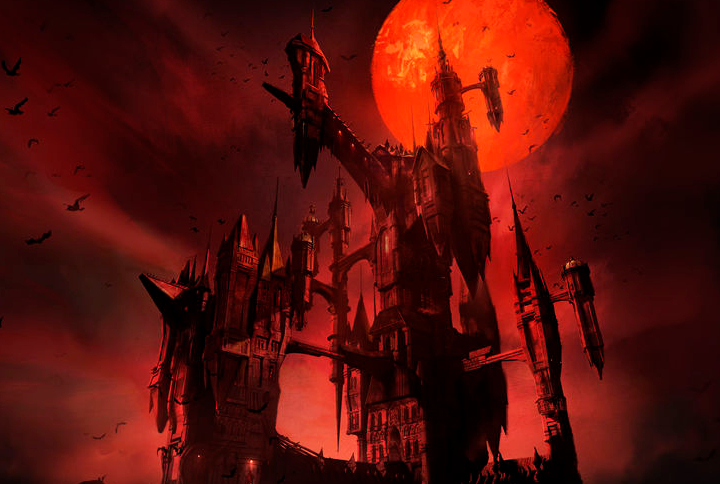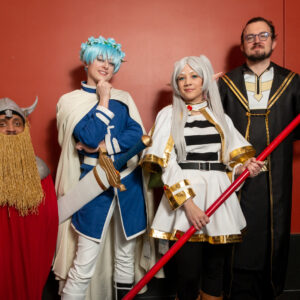Netflix Castlevania Series Is Mostly Bloody Good Fun

Last week Netflix premiered Castlevania, a very good animated movie that it disguised as an animated series. Only four episodes long, it is essentially a two-hour animated film, chopped up into easily bingeable slices. And that is one of Castlevania‘s few real weaknesses.
Based on the 1989 Konami game Castlevania III: Dracula’s Curse, the Netflix series is one of the best adaptations of a game into a movie or series I’ve seen. While some of the credit for that goes to novice director Sam Deats, the bulk of the credit has to go to series writer Warren Ellis.
A comic book veteran, Ellis has some of the most cinematic writing in the medium. His run on Iron Man was collected in the trade paperback Iron Man: Extremis and was the basis of the movie Iron Man 3. To get a sense of some of the best of his writing, check out his DC work on Transmetropolitan and Hellblazer, and Marvel work on Moon Knight and Karnak. Ellis excels at writing action with no need for much dialogue, but also is a solid writer of complex characters, expressed through realistic dialogue.
The movie — oops, series — Castlevania is set a couple hundred years before the first game in the series, and tells the story of Trevor Belmont (Richard Armitage), of the storied clan of vampire hunters, the Belmonts. He is convinced to fight against the hordes of demonic creatures that Dracula has set loose upon Wallachia in the late 15th century. Assisting him (eventually) are two of the characters that can be used as assistants in the game, although the third is not yet introduced. This may be because this character’s main role in the game — working through the platforming elements — seems to be something Trevor and his other companions can do fine by themselves.
Ellis fleshes out the basic storyline of the game, giving Dracula a reason for unleashing demonic hordes on the people of Wallachia beyond just being a stereotypical “evil bad guy.” But that motivation completely negates one of aspect of the game story. In the game, the Church asks for Trevor Belmont’s help, but in the series the Church has become yet another enemy, being responsible for Dracula’s rage. The Church is represented mainly by the Bishop, voiced by a completely unrecognizable Matt Frewer.

Frewer is excellent as the Bishop, dripping with self-righteous menace. And Armitage, best known as Thorin Oakenshield from The Hobbit movies, is wonderfully understated as the drunken reluctant hero, Trevor Belmont. And another important character, not named to avoid spoilers for people not familiar with the game, is voiced by James Callis, best known as Dr. Gaius Baltar from Battlestar Galactica. Even the minor secondary characters, like the two angry bar patrons, are both written and acted well.
But those two barflies are indicative of one of the major problems with this short series. Ellis has to write a lot of exposition to explain the state of Wallachia in the late 15th century and set up the back story of the Belmonts, the Church and the magic using Speakers. While Ellis creatively uses these angry bar patrons to deliver some of the exposition early on, it is still a lot of explaining dialogue. And in later bits of exposition he can’t rely on this tool, so we have a lot of characters standing around talking about “how things got this way.”
In a 12-episode series, this would have been fine — three to four episodes heavy on exposition followed by lots of action and plot twists. But in a four-episode “series” it dominates completely. Kudos to Deats and Ellis for making it not so boring as to completely kill all interest in Castlevania.
The other big problem I have with Castlevania aside from length is changing the Church into a stereotypical bad guy element. I have no love at all for any kind of organized religion — my complaint is that it is a tired trope, not worthy of Ellis.
One area in which Castlevania excels is the animation. It looks much more like an American animated movie from DC and Warner Bros Animation than a Japanese anime series. But it may also be why we only get four episodes until season 2 (already announced) in 2018. The animation seems to be all hand-drawn, with the only CG elements possibly in the form of magic and other special effects. Considering the level of detail in Castlevania, it is easy to believe it takes about the same amount of time to animate as the two-hour movie it really is.
The gore level in Castlevania is more reminiscent of Ellis’ brilliant and controversial short series Black Summer than any of his work with the Big Two comic publishers. We see lots on entrails, and copious amounts of blood. If that or a bit of strong language is a problem, then be forewarned. Since the series is on Netflix it doesn’t have an MPAA or TV rating, but it would clearly be TV-MA or rated R.
Watch Castlevania for the great animation, wonderful voice acting and strong writing, assuming you can handle the frustration of having only four episodes. Four out of five.



